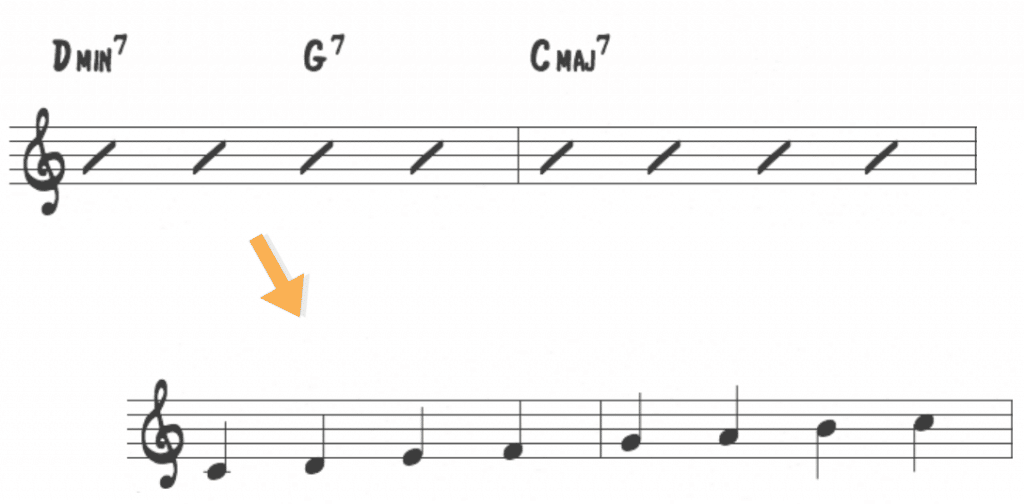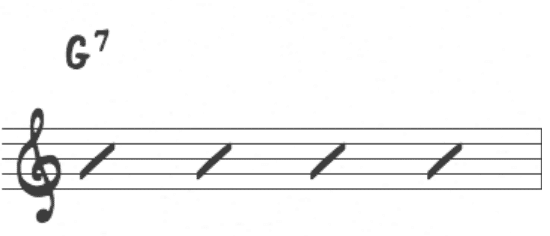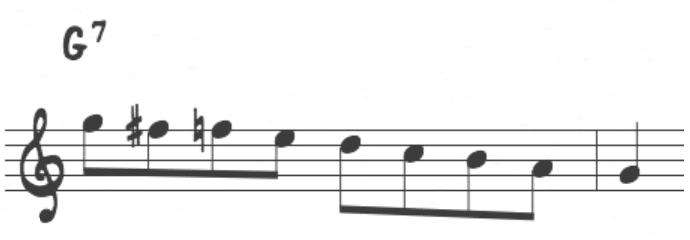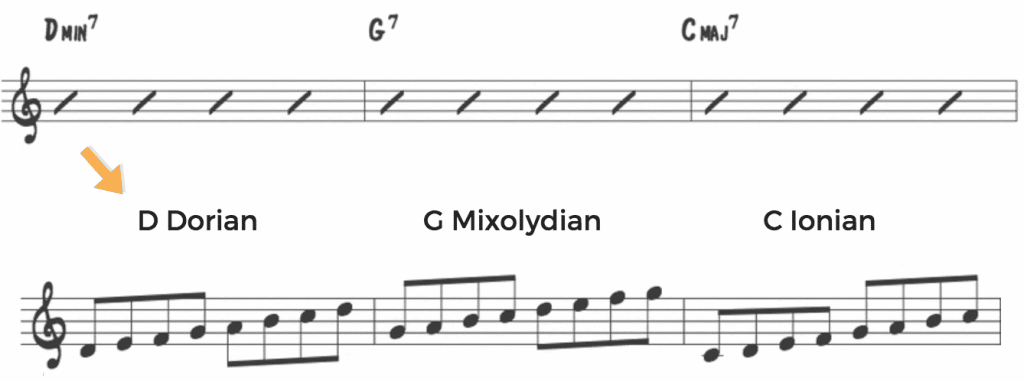When you first began learning how to improvise, chances are the first thing you encountered were scales. Memorizing lists of scales from Major and minor to diminished and octatonic. Knowing which scales work with which chords. It can seem like the practice of scales never ends. This philosophy has become so entrenched within the art of learning improvisation that it is hard to avoid thinking about scales…
Numerous jazz education resources today highlight scales as the method to mastering how to play over chord progressions and improvising like your heroes. Because of this, many students believe that studying scales alone is the answer to reaching their goals. You may have even thought to yourself as I often did: “If I only get all my scales together, then I’ll solve my difficulties with improvisation.”
We get a lot of questions about practicing scales and how they relate to improvisation all the time: How should I use scales when I’m soloing? What’s the best way to practice scales? Do I even need to know my scales in order to improvise?
If you’ve read any of the articles on this site, you know that thinking about a major, minor, or any other type of scale while you’re improvising is only one piece of the puzzle when it comes to the musicianship and harmonic understanding that go into creating a great solo.
You can memorize your F Major scale until you can play it in your sleep:
But, no matter how many times you run that F Major scale up and down, thinking of those eight notes when you’re soloing will not magically turn into a line like this:
To achieve this, you must listen intently to your favorite players, develop your ears, and transcribe some language from your heroes. Improvisation requires all areas of your musicianship, not just the theoretical knowledge of chord/scale relationships.
Scales are only one small part to developing as an improviser. However, knowing and practicing scales, in all their variations and forms, does have some real benefit for your playing – you just have to approach them in the right way.
What scales are not
Scales are not the hidden key to improvisation – if only it were that easy! Contrary to what many method books or jazz educators will tell you, learning all your scales will not guarantee that you’ll be able to improvise in all 12 keys or that you’ll be able to solo successfully over any standard.
Many musicians out there that have all of their major, minor, and diminished scales memorized, but how many of them are great improvisers?
It’s true that scales are a quick way to find all the “right” notes in a chord, but there is so much more to improvisation than the basic knowledge of music theory. Yes, you may be playing the right notes by using scales, but what about the other aspects of musicianship like phrasing, chord resolution, sound, time, and shapes that make a musical line interesting?
While knowing a scale can be useful for playing over a static sound, relying solely on scales to create your solos can severely limit the harmonic possibilities available to you. Thinking of a dorian scale will work for a modal tune with extended sections of minor 7th tonalities, but as you try to improvise over ii-V7’s and more complex progressions, you’ll need to rely on more than just a single scale.
For instance, take a ii-V7 progression in C Major. Because every chord in this progression is functional in C Major, some people rely only on a C Major scale for improvising over this progression:
All of the notes of the C Major scale are theoretically correct over the chords D-7, G7, and CMaj7, but by thinking in this fashion you are ignoring the many harmonic possibilities within each chord as well as the resolutions inherent between the chords.
Simply put, by just using one scale for your improvisation, you are ignoring one of the strongest resolutions in all of Western music: V7 to I.
In a similar sense, the idea of relying only on specific scales for certain chords can be extremely limiting as well. Say if every time you saw a G7 chord:
You played a G7 bebop scale in some variation:
Those notes technically work, but after awhile of relying on that one scale, your playing will get very boring and predictable. If this bebop scale is your only option over a V7 chord, you’re severely limiting the harmonic possibilities of a very versatile chord.
When this same concept is applied to the separate chords in a ii-V7 progression, you’re results will be equally boring:
With this mindset of a specific scale for every chord, you are not only missing the strong resolutions between the chords, but your soloing will sound very disjunct because you are switching scales every bar.
The problem with teaching improvisation exclusively through scale theory is that students will only use scales as they go to improvise. Every chord will be limited to 8 notes of a corresponding scale…
You want to think about playing meaningful musical phrases, about the chords and the inherent resolutions between these chords rather than only the basic scales as you navigate the progression to a tune.
What scales are
Scales are a tool that allow you to gain some essential technique and harmonic awareness, aiding you immensely as you learn the jazz language.
Before you begin to learn any language, you need to know the building blocks that are the basis for that lexicon – for spoken languages, this is the alphabet. Every language has a unique alphabet that is the minimum basis for constructing the developed language. Each letter represents a syllable or sound and can be combined and varied in many ways.
However, just knowing or memorizing the alphabet does not mean that you can form words, phrases, or meaningful statements in that language. By memorizing the alphabet and pronouncing each unique syllable you have acquired the minimum technique to begin learning that language.
The same is true of musical scales.
Every note of a scale has a unique sound and function within a chord and can be combined with other notes or groups of notes within the scale in numerous ways. You need to know how each scale degree sounds and be able to hear the relationships (intervals) between the different notes of a scale.
Just as knowing the alphabet doesn’t mean that you can speak the language, knowing a scale doesn’t allow you to create ideas and phrases in this musical language as you improvise. But, once you’ve got your scales down, the task of learning the jazz language, whether it’s transcribing solos, learning tunes, or working out lines in all 12 keys, will be significantly easier.
The bottom line is that you need to have proficiency in every key in order to play what you are hearing. Scales are a good preliminary step to gaining technique and fluency in all 12 keys. You can have great ears and theoretical knowledge, but if you don’t have the technique to translate this to your instrument, it’s all for naught.
This is where you can use scales to your advantage.
Benefiting from scales
Knowing all your basic scales (major, minor, diminished, whole-tone, pentatonic…) is a necessary first step in understanding harmony and gaining some facility on your instrument. This goes without saying and is precisely why many educators use scales to teach improvisation.
If you don’t have all of your scales memorized and the technique ingrained into your fingers – you need to do it now. Don’t sweat it if you don’t have it all together today, with an effective daily routine you can get your scales down in no time. Just keep in mind that memorizing scales is only scratching the surface to understanding harmony and improvising creatively over a chord progression.
Think of scales as a necessary prerequisite that you need in order to progress in this music. A first step that will familiarize you with harmony and give you some technical tools as you transcribe lines, learn language in all 12 keys, and learn tunes. Scales are an effective way to get familiar with the basic sound of a chord, but they shouldn’t the primary source of material for your improvisation.
Building technique
OK, we’re assuming here that you’ve got all of your scales together at this point. The next step is to expand your technique by exploring all of the variations possible within each scale. Practice your scales in every mode, in thirds, fourths, fifths, sixths, etc. Practice classical etudes, develop scale patterns and create your own exercises for each scale. And most importantly, practice all of these in all four directions. Your goal is to be completely comfortable with every scale.
Refer to these articles for an in-depth explanation of how to practice these ideas:
When you study every possible variation of each sound, it’s surprising how much you can do with just one scale.
Gaining musicality from jazz scale practice
When you are practicing scales for technique, to get the most benefit from your time in the practice room, you want to focus on other aspects of the scale besides the notes themselves. Start to think about the musical aspects of a line that will aid in expression. Explore different types of articulation, accents, time signatures, and note groupings.
Remember, these exercises aren’t just mindless activities to be drudged through in the practice room. If practiced correctly, they are a vital part of your practice routine that will greatly enhance your improvisation and musicality when you perform.
Articulation
Say you’re practicing an F Major scale ascending in thirds:
Once you have the notes and fingerings down, try using different articulations.
Slur the entire line:
Legato tongue every note:
Staccato tongue every note:
Use jazz articulation:
Get comfortable playing with any of these articulation styles or even a combination of them. When you’re in the middle of a solo, you want to be able to articulate and express yourself in a number of different ways.
Odd note groupings and playing over the bar line
Besides working on different ways of articulating the scales that you’re practicing, experiment with grouping and accenting the notes in new ways. Instead of playing every scale in eighth notes or emphasizing the downbeat of every measure, try using odd note groupings and accenting different parts of the measure to imply different meters.
For example, take the same F Major scale in ascending thirds:
Now put the scale into three note groups by slurring every three notes and accenting the first of each group of three:
By grouping the scale in this way, you are creating a dotted quarter note feel that extends over the bar line.
Now try this same concept, but with 5 note groups:
Try the same thing but in triplets this time:
The variations are endless, see what you can come up with. From the same scale you can create and develop some new skills that will incorporate interest into your solos.
Practicing these articulations and getting comfortable with this idea of grouping notes and implying different time signatures will improve the musicality of your improvisations. You don’t have to play the exact scale exercise or articulation pattern as you improvise, but rather use these techniques in the lines that you are playing. All of these aspects will prove to be beneficial as you create lines on the fly during your improvised solos.
Explore new harmonic applications
Another thing to think about as you practice these scales, patterns, and different articulations is how to apply them harmonically. Don’t limit these scales only to their related chord (F Major scale goes with an FMaj7 chord, or a D dorian goes with a D-7 chord, etc.), try to think outside the box and find some new harmonic applications. These new techniques that you’re developing in every key can be applied to different chords and new harmonic settings.
For example, let’s take that F Major scale in thirds one more time:
Instead of only thinking of this scale as related to an FMaj7 chord, see what other chords this pattern would work over. To start, look at the notes in the scale and think about chords that are related to FMaj7. For this particular exercise, try G-7:
Or C7sus:
Or even BbMaj7#11:
The goal is to get away from the mindset that variations of an F Major scale only work over an F Major 7 chord. The exercise or technical work that you’re doing in one key can be applied to a number of different harmonic settings. Sit down at the piano and see what new harmonic possibilities you can come up with for these over-used scales.
For the modern improviser, scale practice has its share of pros and cons. On the one hand, scales should not be the only source from which you’re creating your solos , but on the other hand they can be very useful when practiced and applied in the right way. Strive to practice your scales creatively and musically so that you’re not ingraining the same boring scales ad infinitum and cut-and-pasting them directly into your solos.
Use the exercises and ideas discussed above to create a fresh approach to practicing scales. When you add different articulations, time signatures/feels, and harmonic applications, the practice of scales can transform your playing and raise your techniques to new heights.

























